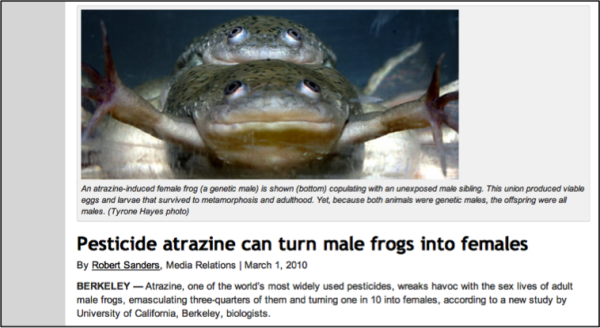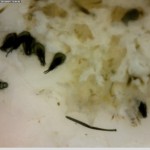 This is a guest post by Chelsea Rochman. Chelsea is a post-doc at the University of California Davis. This is her fourth guest post at DSN, and the first one to come with this.
This is a guest post by Chelsea Rochman. Chelsea is a post-doc at the University of California Davis. This is her fourth guest post at DSN, and the first one to come with this.
WARNING: Some content may not be acceptable for a younger audience. (Note from Miriam: It’s ok, Chelsea, nothing in this post is at all out of the ordinary for DSN. It’s salty in these here parts.)
Strange title you say? What can sex possibly have to do with the combination of fish and plastic debris? NO, this is not related to the recent news article regarding a strange object found in the stomach of a fish! Instead, it arises from a recent study performed in our laboratory whereby we were equally perplexed to find something very fishy (no pun intended!) in the testes of a male fish exposed to plastic marine debris.
Sex
Since the release of Rachel Carson’s Silent Spring in 1962, we have heard eerie stories about alligators with abnormal penises from exposure to DDT, amphibians with eggs in their testes from exposure to atrazine and snails turning hermaphroditic from exposure to tributyltin —all considered hard evidence for endocrine disruption.
Well, this all sounds frightening, depressing and/or a bit like a dark comedy sketch, BUT what is endocrine disruption really?? Well, put simply it is literally any disruption to the endocrine system. The endocrine system is the system in the body of an organism that controls our hormones. As such, it’s critical for functions we all know well including stress before a deadline, the infamous running high, the dreaded PMS, sexual pleasures and arguably most importantly, reproduction (critical to maintaining a population).
What does this have to do with fish??
Well, fish are often used in scientific research assessing the endocrine disrupting hazards of chemicals on wildlife. Fish are a) important for human consumption, b) arguably great ecological indicators of the health of aquatic habitats, c) sensitive to endocrine disruption and d) live in regions that ultimately receive our waste (ever read the phrase, “all drains lead to the ocean”). As such, fish are exposed to many of the chemicals produced and consumed by us and we must understand the hazards of the cocktail of contaminants entering our water bodies. This keeps researchers very busy, as the number of new chemicals synthesized and marketed has increased exponentially over the past fifty years.
OK… and plastic debris?
In the past, endocrine-disruption was not addressed when assessing the hazards associated with synthetic chemicals, and as a consequence chemicals once considered benign have become ubiquitous as environmental contaminants and threaten biodiversity. Similarly, hazards associated with plastic in marine habitats were also likely not addressed when assessing hazards associated with plastic products. Today, plastic debris is ubiquitous in the marine environment and is a contaminant of concern recognized by several countries and international organizations.
As I’ve mentioned before, plastic debris should be considered as a multiple stressor in aquatic habitats as a consequence of the physical toxicity and large mixture of chemical contaminants (i.e. ingredients and environmental contaminants that accumulate on plastic debris) associated with it. Several of these plastic-associated chemicals have been linked to endocrine disrupting effects. Bisphenol-A, now banned on baby products in several states including California and in Europe, can disrupt endocrine-system function. Furthermore, there is evidence that phthalates and nonylphenol, additives to several plastic types, are estrogenic. As such, plastic marine debris is likely associated with a mixture of endocrine-disrupting chemicals. As such, it is critical to assess if the plastic debris that thousands of animals associate with food could initiate any of these eerie hormonal effects described.
The story
Somebody has to do the dirty work, so we dove in and asked if fish experience endocrine disrupting effects when they eat our plastic waste for dinner. Some of you may remember this experiment from a previous blog post. What we did not share then, and will share here, are some troubling results sparked by hypotheses spun from one strange discovery: the very abnormal testes of a male fish fed marine plastic debris.
The image above shows the testes of a normal fish fed a control diet (left) next to the testes of a fish exposed to plastic marine debris (right). The testes of this adult male fish exposed to plastic marine debris has rather abnormal germ cell proliferation. We are unsure whether these abnormal germ cells will lead to intersex or reproductive impairment, but the abnormality of these gonads and the similarity to female germ cells is cause for concern.

Our results show early-warning signs of endocrine disruption in fish exposed to a mixture of plastic and sorbed contaminants, suggesting that plastic marine debris, reportedly ingested by multiple wildlife species, may alter the functioning of the endocrine system in aquatic animals.
Most importantly, we report evidence at the molecular and organ level, for disruption to the endocrine system caused by the “cocktail” of contaminants associated with polyethylene deployed in an urban bay. Of major concern should be the permanent effects that exposure can have during critical early- life stages of organism development, which may impair reproductive success and harm wildlife populations. Still, chronic exposure to environmentally-relevant levels of endocrine-disrupting chemicals can have an effect after maturity as reported here. Chronic exposure is typical of marine plastic debris as it accumulates in habitats and is a persistent material that can last for decades.
Current waste-management strategies for plastics remain ineffective, and in parallel global production of plastics continue to increase at an average rate of about 9% per year. Thus the current rate of infiltration of this material into aquatic habitats is likely to increase. Because there have been several reported incidents in wildlife of population declines resulting from the release of endocrine-disrupting chemicals, our results suggest the need for future studies to test hypotheses regarding endocrine disruption in wildlife as a result of exposure to the growing accumulation of plastic debris.
The published study is found here: Rochman et al., 2014, Science of the Total Environment.









Good post!